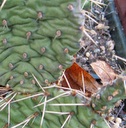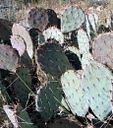Opuntia
fragilis- Brittle Prickly Pear
To those familiar with the large, shrub-like prickly pears of Arizona,
Opuntia fragilis would hardly be recognized as a close relative of
those impressive plants, but indeed it is! However, it has much smaller
pads than most Opuntia species, usually just 1 - 2" long or
occasionally a little longer. The pads are "fat" and can be cylindrical
to slightly flattened in shape. Some older references state that the
pads are invariably cylindrical, but a thorough inspection of a sample
of wild O. fragilis plants will reveal that this definition is too
narrow. The pads have spines that may be rather soft and white to more
rigid and somewhat golden or brownish in color. The spine color also
varies according to the time of year. In June, yellow flowers are
produced, but some forms of this species are rather shy to flower.
The names "fragilis" and "Brittle Prickly Pear" are assigned to this
plant for a reason; that is, the pad joints are very brittle and apt to
break with very little force. With this in mind, and also considering
the pads are so small, the plant is seldom able to grow taller than
about 6". Most frequently, it forms broad, low mats on sunny, dry south
or southwest facing slopes with gravelly or sandy soil. It is at its
best in isolated areas where competition from other plants is minimal.
It blooms but infrequently, as its distribution pattern seems to be
from broken off pads. This I can attest to, as I battle with crows all
the time. These vicious winged devils routinely come down to pull small
pots out of their flats, steal the tags and leave them scattered all
over. I HATE them! I finally chili powdered all of these flats, and
sprayed them with Cayenne pepper as well.
They moved on to my Cacti flats, and damn it … they stole a couple!
When I told that to a friend of mine, she laughed and said that they
had just gotten stuck to their feathers. So off they flew with my
little cacti attached and now they assuredly have a new home.
Opuntia fragilis is distributed widely throughout North America. It is
the only cactus species native to western Washington. It used to be
widely distributed in the areas found within the Olympic Rainshadow.
Sequim, Pt. Townsend and the San Juan Islands. In British Columbia, the
plants can be found in the Gulf Islands in the Strait of Georgia.
Opuntia fragilis was once more common in my own Sequim area, but now is
very rare and their seems to be little interest in preserving this
unique cactus. The San Juan Islands are doing a much better job of it.
Perhaps it is the San Juan Island rabbits distributing the plants
around..


